When a casualty’s injury warranted evacuation from the battalion aid station/casualty collecting point, and the treatment he had received had stabilized his situation enough for him to be transportable, he would enter the second echelon of the Chain of Evacuation.
The second echelon was the responsibility of the medical battalion.
Just as all the medical care in the first echelon was focused on getting the casualty to the battalion aid stations, the care in the second echelon was focused on getting the casualty to the clearing stations of the medical battalion. Evacuating the casualties from the first echelon to the clearing stations was the responsibility of the collecting units of the medical battalion.
Infantry division vs armored division
The medical battalions of infantry divisions had a different organization than their armored counterparts.
In the infantry divisions, the medical battalions consisted of a headquarters and headquarters company, three collecting companies (“A”, “B” and “C”), and one clearing company (“D”).
Each collecting company would support the battalion aid stations of one infantry regiment. The men of the collecting company would collect the casualties at the aid stations, relying mostly on litter bearers. They would transport the casualties first to a collecting station they had set up. Here, at this intermediate medical station, the casualty would be checked by medical personnel and additional emergency treatment could be given, much like the treatment given at the aid stations.
When the medical situation made further evacuation possible, the collecting companies would evacuate the casualties, by ambulance, to the clearing company.
At the clearing company, the casualty would receive more extensive medical treatment than thus far had been possible.
The medical battalion of an armored division consisted of a headquarters and headquarters company and three identical armored medical companies (“A”, “B” and “C”).
Each armored medical company consisted of one collecting platoon (each with two collecting sections) and one clearing platoon. The collecting platoons did not establish collecting stations, as their infantry division’s counterparts did.
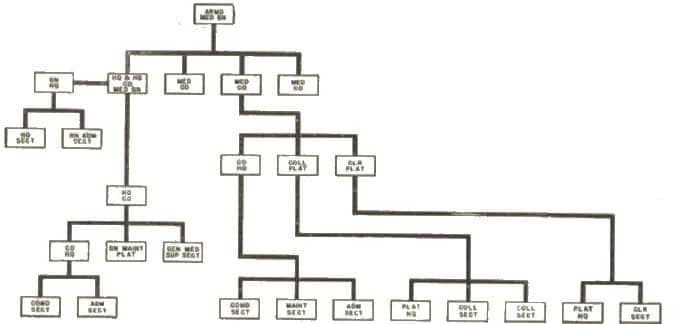
One of the medical companies of the 46th AMB crosses the Moselle river at Hatzenport, Germany, March 1945:
Doctrine stated that one armored medical company supported the units of one combat command. Because the combat commands of an armored division often fought at great speeds and some distance from each other, it was important casualties could be evacuated to their “own” clearing station, within their combat command. This explains the different organization from the infantry division’s medical battalion.
When an armored division followed the doctrine of two combat commands and a reserve command (as the 4th Armored Division did most of the time), the third medical company was the reserve medical company, often traveling with Division Trains.
Medical policies 4th AD, as published by the Division Surgeon on 27th April, 1944:
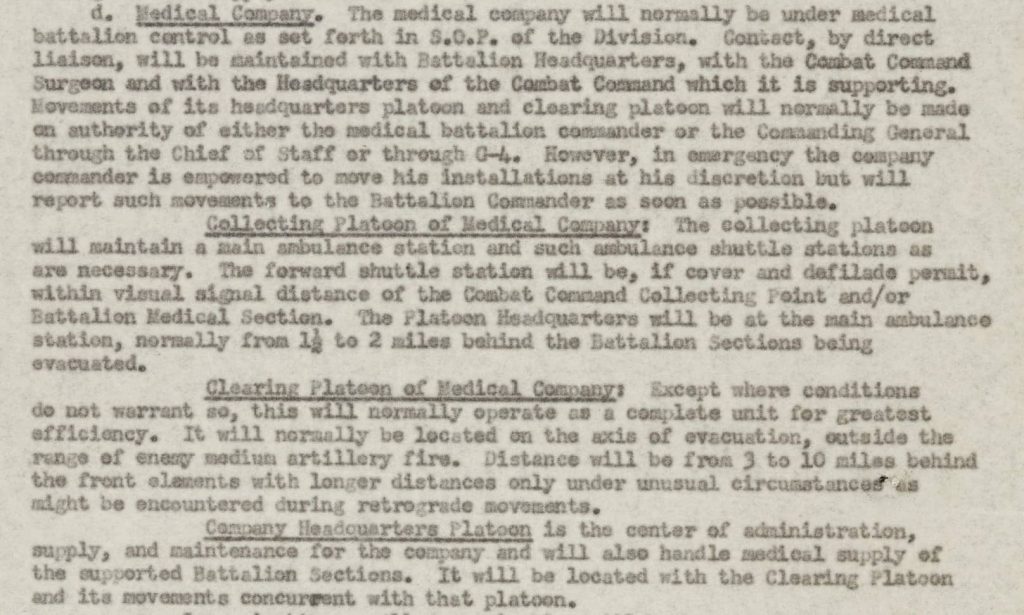
Collecting platoon
The collecting platoon of an armored medical company consisted of two officers and 53 enlisted men. The two officers, together with a Staff Sergeant formed the platoon headquarters. The remaining enlisted men were assigned to the two, identical, collecting sections.
Each section had 5 ambulances, manned by a driver and a surgical technician. The rest of the men were litter bearers. The collecting sections were responsible for collecting all the casualties of the battalions in the combat command they supported, at the battalion aid stations or casualty collecting point. The collecting sections established so-called Ambulance Loading Points (ALP) there.
MR B/46: Collecting Section dispatched to collecting point:
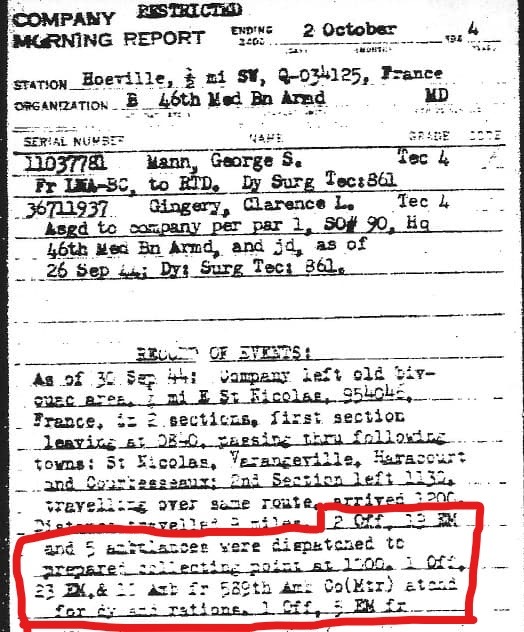
Ambulances of B/46 collecting platoon drive into Susice, Czechoslovakia, May 1945:
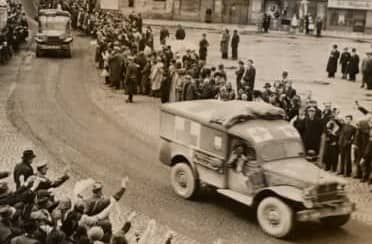
All the men were equipped with medical kits, private, until November 1944, when the surgical technicians were “upgraded” to the medical kit, NCO.
The casualties were evacuated, as fast as possible, to the clearing station of the armored medical company.
Clearing platoon
The clearing platoon of an armored medical company consisted of 5 officers and 28 enlisted men.
The platoon headquarters was formed by one Captain and a S/Sgt. The clearing section was staffed by three medical officers (MOS 3100), one dental officer (MOS 3170), two medical NCOs (MOS 673), five truck drivers (MOS 345), one dental technician (MOS 855), eight medical technicians (MOS 409) and eleven surgical technicians (MOS 861). (for more information: MOS List used)
The core of its equipment were the two surgical trucks. Each provided the facilities, including an operating table, operating lamp, and autoclave, to carry out emergency surgical treatment. This included amputations, the transfusion of blood(plasma), application of splints for fractures, etc.
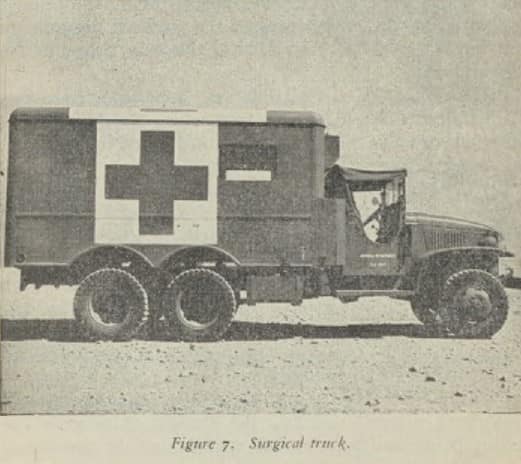
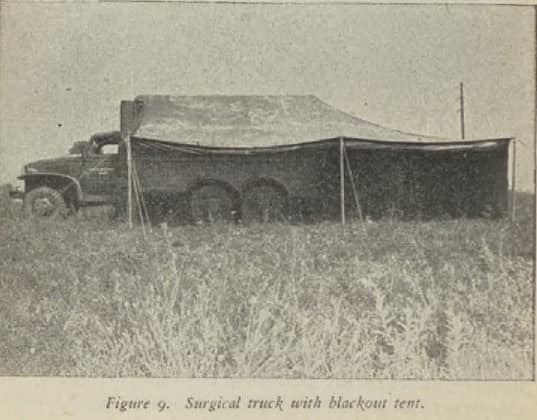
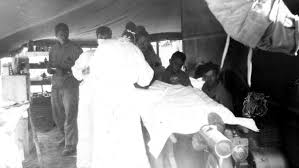
Definitive surgical treatment was left for higher echelon hospitals.
FM 17-80 Armored Medical Units 1944, 40-46: Armored Medical Battalion.
The clearing platoon also had two trucks and two 1-ton trailers filled with medical supplies and equipment.
Casualties were kept in the two squad tents, which also served as admitting, dental, mess, and evacuation departments.
Photo squad tent:
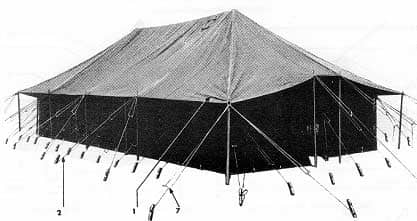
When the situation permitted, the clearing station was set up in buildings. In the morning reports we can see that within 20 minutes after arrival at a new bivouac, the clearing station was open to receive casualties.
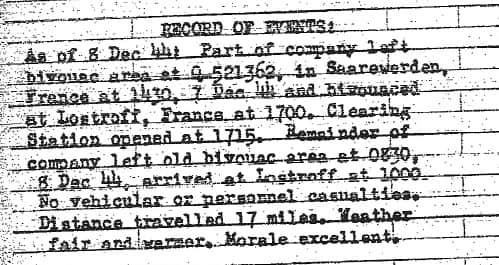
Clearing Station of Company C, 46th AMB in Normandy:
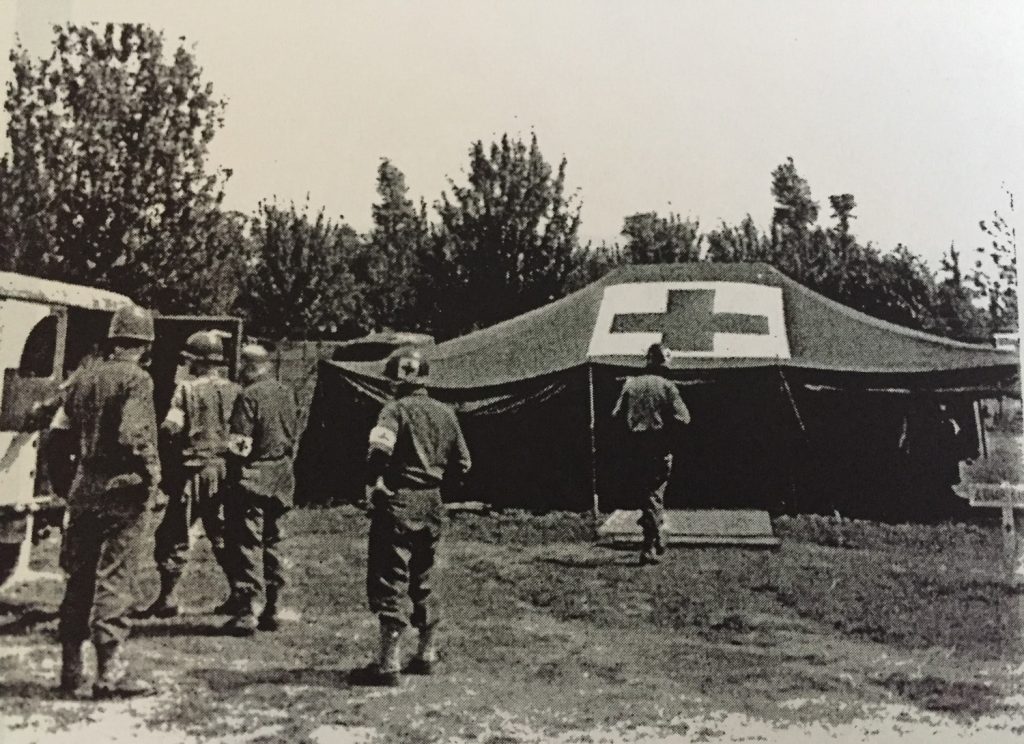
We can find in the morning reports, that Chaplains with their assistants were often attached to the clearing platoons of medical companies. Here they could provide spiritual aid to the casualties (and personnel).

Charles Wilson served as an assistant to Chaplain Arnold, assigned to CCB. In his book From Bastogne to Bavaria with the Fighting Fourth Armored Division 1944-1945, Scenes from the War and Holocaust, he described some of the scenes he witnessed at the clearing station of the supporting medical company (Company B, 46thAMB, most of the time).
“There are moments when we four are zany and behavior seems flip. We are trying to keep our sanity and our humanity in a world that measures time by the throb of pain, and events by the number of wounded men who pass through on stretchers, or pass through wrapped in a blanket for delivery to the graves registration recorders.
We see strange things happening every day. A young soldier walked into our aid station housed in a community hall of a small town. He was naked from the waist up. He approached us, stepping
lightly down the aisle, combing his hair as he walked. As he passed various medics, they stared at his back. There were murmurs of surprise!
I too, looked at him as he passed. His wound startled me!
From the base of his neck, to the sides of his body, and down to his waist, his back brought to my mind a body picture out of a medical book.
The skin on his back was completely blown off. All his back muscles stood out in symmetrical form and functioned as he combed his hair. His vertebrae had the appearance of two rows of white teeth going down from his neck to his waist.
He walked serenely, as though nothing was wrong. He said not a word. He may have been in a state of shock!
The Medics held a puzzled conference to decide what they should do with this unusual medical case.
When I turned away to do other things, they were padding his back with large balls of cotton.
Two Medics lowered a stretcher before me on which a German soldier sat with his arms wrapped tightly around his knees.
In order to examine his problem, the medics felt it to be necessary to unwrap his arms about his knees. When they did, he straightened out on his back. His intestines rolled out of his body and spilled on the floor.
Then they brought in two young men on stretchers. One was German, the other, an American, too young to die. With no apparent injury or blood-letting, they passed away. Bloodless deaths due to shock.
Some soldiers are brought in on their feet psychologically disoriented. They jabber as though they were hit by something that knocked loose their store of words in a jumble of me
Words poured out incoherently with snatches of speech carrying verbal images of the past and present in wild disorder.
We receive information that a large group of German soldiers lie in wait for us over a hill.
The order is given to go after them.
In preparation for the onslaught, our medics set up an aid station in a two-story building.
The ambulances stand by with motors running, and ready to go. Our expectation is that a large number of Germans will be needing medical aid.
The high risk atmosphere creates an uncanny sense of excitement in which men express a brave spirit of determination, along with a strongly felt fear of the unexpected.
I am excited too.
[…]
Ambulances roar up with their litters of the dying and wounded German soldiers.
Our medics work furiously amongst the wounded, doing their best to keep as many alive as possible. indiscriminate compassion!
I have never seen a better expression of Christ’s command to “love your enemies.”
Stretchers extend from wall to wall.
A few German soldiers, lightly wounded, stand against the walls, or slump down, holding the source of their pain. Almost everywhere in the room I can hear the low groans of unsedated victims of war. The room becomes a tubed jungle of plasma lines descending from hooked heights into the arms of pale-faced men.
“Blood” is the word in simple description. Blood-soaked cut away uniforms lay piled around stretchers. Blood drips on the dirty floor and trickles into makeshift aisles. Amidst the intensity of my effort, pulling, lifting, easing, speaking, praying, crying my heart out, following to the best of my ability the tense orders of surgeons bespattered like butchers in a slaughterhouse, I begin to feel the emotional tension created in my own being by the terrible sight of so many wounded and dying men in such close confinement.
Something inside me is draining my own life away. My head is bursting as I stand aside to rest and observe.
[….]
I listen to the moaning and groaning of the suffering men; a soft lullaby of pain that sounds to me like a funeral dirge for the dying men around them. A noisy bustle of bodies near the door catch my attention. An American soldier, guides another American soldier into the building. He appears unwounded except that his face is smudged and his eyebrows singed, and the cloth of one pant leg is gone, exposing a bruised knee. He babbles in a subdued voice. I am startled by the shock of recognition! It is Wilcox!
I ease over to him. I wrap my arms around him, holding him tight. I say: “Everything’s all right, Wilcox.” He trembles uncontrollably. I tremble too. Words pour out of his mouth, words in meaningless disorder. He sees me, and he doesn’t see me! He offers no response to my questions.
Instead he responds to some inner necessity to let words out, like a broken dam flooding the plains of his consciousness. His verbal system of logical expression has been knocked out!
Words fall from his mouth in discordant bunches, creating faulty images of thought. Words shape up like a poorly pieced together broken mirror of the mind.
His words are a mixture of past and present: farm, cows, dad, army, hate, fear, weak obscenities, and a stuttering phrase intimating that he won’t make it.
His forehead slips from my shoulder. He buckles at the knees. He sobs and stutters as a soldier places him on a chair. His head nods as he falls into a pathetic silence. My helper asks: “Do you know him?”
“I sure do. Do you know what happened to him?” “He was delivering mail. Two other guys were with him in his jeep. They got caught in the crossfire, ran over a mine that exploded jeep and wrecked his vehicle. ” Then casting a glance towards the entrance which again bustles with activity and noise, my spokesman says: “Here they come now! “
Two aid men escort a soldier into the room. His uniform is in tatters, much of his hair burned off his head. Encased in his very dirty face are two circles of blood where once his eyes had been.
He is gingerly brought to the chair behind which I am standing, where he is seated.
Wilcox stares at him with a wild look in his eyes as he sits a few feet away.
A doctor brings two balls of cotton, puts them in my hands, saying: “Hold these gently in his eyes. ”
I cautiously place the cotton balls in his eye sockets; and as I do, a stretcher is brought in and placed on the floor in front of us. It holds the remains of a dead American soldier.
Wilcox, wild-eyed, stares at the dead man, and then back at my patient.
My patient, aware of the discussion as to where the stretcher should be laid, cries out in a pitiful voice: “Please sir, take care of my buddy first. Take care of my buddy first! ”
Again, the spirit of Jesus is amongst us.
My soul cries out in anguished prayer: “O Lord! Where the pain and suffering is greatest, there You are! ”
A doctor, noticing my unnerving mutterings, gently releases me from my self-denying patient.
I look around. A doctor is ministering to the needs of Wilcox. For the moment there does not seem to be anything more I can do.
I squeeze past the crowding press of human suffering to catch a gulp of fresh outdoor air.
[…]
The cumulative stress, tension, and anxiety of the months before, has caught up with me. The stress of living amidst the unalterable conditions of suffering and death overcomes me. I can no longer cope with the tragic events of the day.
Everything is bloody! People, medics, the floor and the walls of the aid station, the blankets, the sun itself, setting like a red ball of angry fire in a blood-streaked sky!” (page 182-188)
Reserve medical company
The reserve medical company (in the 4th Armored Division, this was often Company C, 46th AMB), served three purposes: first, it supported the units in Division Trains for second echelon medical care.
Secondly, it was a reserve force for the two supporting medical companies in the combat commands. It meant that personnel and equipment from the reserve medical company could be sent forward to strengthen the medical companies in the combat commands. When the reserve command was deployed as a third combat command (then called CCR), personnel and equipment from the reserve medical company would be dispatched there to support it for the second echelon medical service. This was done for instance during the Battle of the Bulge, when roughly the equivalent of a collecting section and an acting combat command surgeon was sent to CCR.
46th AMB S-3 Journal: CCR
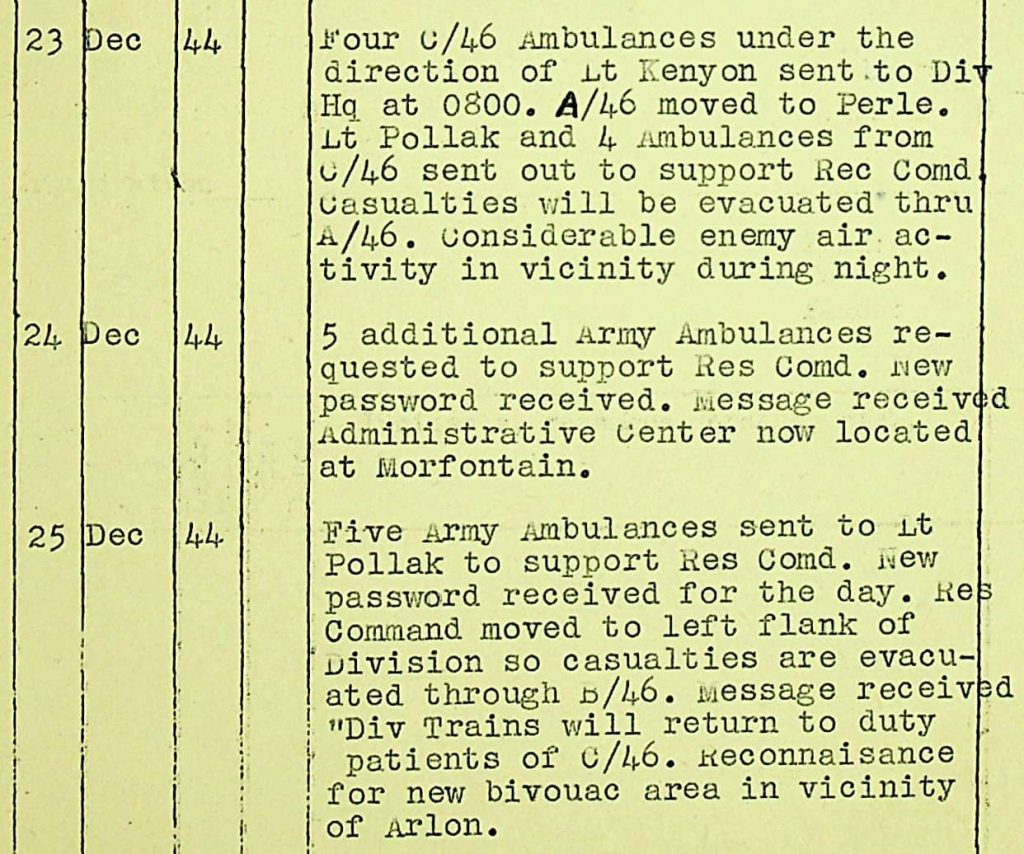
The third role the reserve medical company played, was that of “convalescent station” /”auxiliary treatment station”/ “division rest center”. These three names are used in different documents, describing the same function. The reserve company was the medical station, where many of the casualties from the frontline medical companies were brought when it was thought that they might recover enough within a few days, to be able to be returned to the front again.
46thAMB AAR division rest center:

Division Surgeon Journal 1944-auxillary treatment station:

This included the bulk of the combat exhaustion cases. The center was therefore supervised by the division neuropsychiatrist, Major Mericle.
From here, men were sent back to the front whenever possible. When they did not recover sufficiently in a few days, they were evacuated back to the third echelon medical installations.
Evacuating the wounded from all the clearing platoons were ambulances of the (Third) Army. Starting the third echelon of the Chain of Evacuation, these ambulances would collect the wounded and transport them to (Third Army) Field Hospitals or Evacuation Hospitals. During their assignment to a division, the personnel of these ambulances was “attached for rations only”, meaning that the medical company mess received extra rations to feed the ambulance teams (just like it would for any attached Chaplains).
Having these ambulances at the clearing stations, meant that casualties could be evacuated as soon as their medical condition allowed, without the need to wait for the arrival of the evacuating ambulances.
Jim Sanders was one of the ambulance drivers in the 585th Ambulance Company (mtr.). In his book, Saving Lives, Saving Memories: A 19-Year Old Ambulance Driver in the Wake of Patton’s Army, he describes his experiences on his first assignment, evacuating the casualties of the 4th Armored Division:
“As ambulance drivers it would be our job to take wounded soldiers, who had already been given emergency treatment by front-line medics in hastily set-up aid stations [clearing stations], back to the nearest evacuation (“evac”) hospital for more extensive treatment. We would be, so to speak, taxi drivers for battle casualties, transporting wounded soldiers who might still be patched up and returned to service, or at least not returned home in coffins.
That same night Captain Brawerman decided to take our platoon of ten ambulances to find the battalion aid station [clearing station] of the Fourth Armored unit, to whom we’d now been officially assigned.
[..] The aid station was set up next to an extensive field bordered by trees, whose grass was stained with blood fresh enough that it glistened bright red. Driving onto the field, we lined up our ambulances and immediately began to take on wounded, two on each side of the interior, one above the other. Our first load included a soldier on the lower right litter whose head was wrapped with a bandage soaked through with blood. A medical officer came by, peered in and said, “Pull him out-he’s dead.” Through the years I’ve wondered who that soldier was, and about the family he would return to in a casket. But with no time to reflect, we simply removed the dead man, gently laid him on the grassy field and loaded another wounded soldier in his place. And with that we started back to an evac hospital in Normandy, newly initiated into the harsh realities of war.” (page 41, 43).
The 585th Ambulance Company (mtr.) was first assigned to the 4th Armored from August 1st to August 12th, 1944, with a platoon each attached to Companies A and B of the 46th AMB. In the course of the War, it would be reassigned a couple of times to provide third echelon evacuation.
Division Surgeon Journal 585th Amb. Co:

Between July 1944 and May 1945, the medical companies of the 46th AMB treated a total of 20.016 patients of whom 14.912 were of the 4th AD. A total of 3850 patients were able to return to their units after treatment in the 46th AMB medical stations.
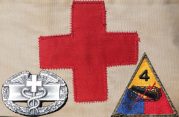
Pingback: Tec5 Joseph N. Korzeniowski - Part 4 - Patton's Best Medics
Pingback: Tec5 Joseph N. Korzeniowski - Part 5 - Patton's Best Medics